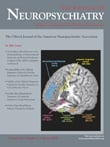Marked Hyperphagia Associated With Total Loss of Satiety in Alzheimer’s Disease
To the Editor: The neuroanatomical basis for hyperphagia seen in patients with dementia is not well understood. We describe here a patient with marked hyperphagia associated with complete loss of satiety who provides clues to the site of involvement.
Case Report
An 84-year-old man with progressive memory loss for 4 years was diagnosed to have Alzheimer’s disease and followed clinically over 3 years. His Mini-Mental State Examination (MMSE) score was 19. Language functions were normal. Cranial MRI scan revealed mild cortical atrophy. Serum B 12 , Folate, T 3 , T 4 , and thyroid stimulating hormone levels were normal. Marked hyperphagia (confirmed by detailed history 1 and direct observation) was noted about 1 year after onset. Under direct observation, the patient was noted to complete a heavy meal (estimated 1800 calories) and a few minutes later to be eating again. He denied feeling full and said he wanted more food. Family members noted that he had larger meals and also ate more between meals. There was also evidence of searching for food—getting up in the middle of the night to eat an entire packet of biscuits or sugar—to an extent that food had to be hidden. However, on no occasion was he noted to have inappropriate behavior or hyperorality (examining or touching objects with lips). There was no history of wandering or eating inedible items. It was noted that concomitantly with marked hyperphagia there was progressive weight loss, from 130 pounds to 108 pounds over 3 years. Extensive physical examination and laboratory testing did not reveal any other abnormality.
Comment
Among the behavioral changes reported to occur in dementia are alterations in eating habits. Reduced food intake has been described in 16% to 63% of Alzheimer’s disease patients and increased food intake (hyperphagia) has been described in 9% to 26% of Alzheimer’s disease cases. 2 In previous studies, excessive eating has been associated with weight gain, and greater frequency of wandering, unpredictable behavior, inappropriate dressing or bodily concerns and threatening self-harm, making it difficult to pinpoint the cause of the hyperphagia. 3 As our patient was cooperative, and had no other behavioral abnormalities or language dysfunction, it was possible to make the important clinical observation that his hyperphagia was characterized by the complete absence of satiety. Meal size and termination is determined by the onset of satiety, a biological state induced by neurohumoral stimuli (such as gastric distension and the gut peptide cholecystokinin released into the circulation after a meal) that leads to meal termination. 4 Recent research points to parasympathetic afferents activated by such stimuli converging on the nucleus tractus solitarius, an area of the caudal brain stem that plays an important role in satiety and meal termination. 5 This hypothesis is supported by the finding that even in the absence of all hypothalamic influences, normal satiety is maintained. 6
Involvement of brain stem nuclei (locus ceruleus, substantia nigra) has been described in Alzheimer’s disease. 7 We speculate that damage to the nucleus tractus solitarius in the brain stem in our patient led to the loss of satiety and consequent hyperphagia. Additional damage to neurons in the cingulate gyrus or lateral hypothalamus may have led to excessive catabolic activity and weight loss in spite of markedly increased food intake. Neuropathological analysis in dementia patients with hyperphagia may further define the neuronal dysfunction underlying this curious behavioral abnormality.
1 . Cooper Z, Fairburn CG: The eating disorder examination: a semi-structured interview for the assessment of the specific psychopathology of eating disorders. Int J Eat Disord 1987; 61:1–8Google Scholar
2 . Ikeda M, Brown J, Holland AJ, et al: Changes in appetite, food preference, and eating habits in fronto-temporal dementia and Alzheimer’s disease. J Neurol Neurosurg Psychiatry 2002; 73:371–376Google Scholar
3 . Smith G, Vigen V, Evans J, et al: Patterns and associates of hyperphagia in patients with dementia. Neuropsychiatry Neuropsychol Behav Neurol 1998; 11:97–102Google Scholar
4 . Schwartz MW, Woods SC, Porte D, Seeley RJ, Baskin DG: Central nervous system control of food intake. Nature 2000; 404:661–671Google Scholar
5 . Ritter S, Dinh T, Friedman M: Induction of Fos like immunoreactivity (Fos-li) and stimulation of feeding by 2,5-anhydro-D-mannitol (2,5-AM) require the vagus nerve. Brain Res 1994; 646:53–64Google Scholar
6 . Grill H, Smith G: Cholecystokinin decreases sucrose intake in chronic decerebrate rats. Am J Physiol 1988; 254:R853–R856Google Scholar
7 . Zarrow C, Lyness SA, Mortimer JA, et al: Loss is greater in the locus ceruleus than nucleus basalis and substantia nigra in Alzheimer and Parkinson diseases. Arch Neurol 2003; 60:337–341Google Scholar



